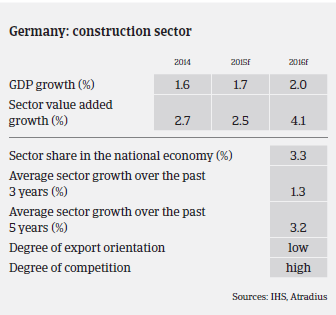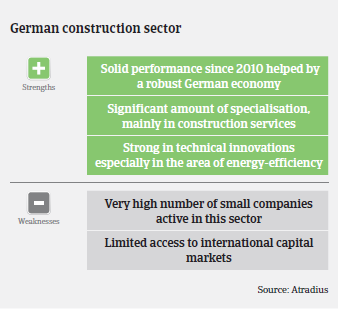Construction output is expected to increase again, but poor payment behaviour of public buyers remains an issue.
- Growth expected to accelerate in 2016
- Poor payment behaviour of public buyers remains an issue
- Decrease in insolvencies slowing down

The German construction sector accounts for 3.3% of German GDP. Within the industry, 90% are small businesses (less than 20 employees) accounting for 45% of total construction turnover. 35% of sector turnover is realised by companies with 20 to 100 employees, and the remaining 20% turnover share is generated by large companies with more than 100 employees. Small companies are mainly focused on residential construction (about 70% of operations), while large building companies generate most of their turnover abroad.
The performance of the German construction sector continued to be positive in 2015, although turnover growth slowed down to 1% after a 4.1% increase in 2014. According to the German Builders Association, turnover growth will increase 3% in 2016, to EUR 103 billion. Residential construction is expected to increase 5%, driven by a high employment rate, low interest rates and the need to provide new housing for the high number of refugees and asylum seekers. Public construction is expected to increase 4% due to higher infrastructure investment, while commercial building output is forecast to level off this year.
On average, payments in the German construction sector take around 45-50 days. Instances of payment default decreased again in 2015, and this positive trend is expected to continue in H1 of 2016. Construction businesses´ dependence on bank finance is not overly high, given that payments in advance or instalment payments by investors are a major source of financing.

However, the poor payment behaviour of public buyers still remains an issue, as it puts a strain on suppliers’ liquidity. With demand increasing and profit margins stable, construction insolvencies have decreased in recent years and are expected to decline further in 2016, in line with the overall trend in Germany (business insolvencies in Germany are expected to decrease 2% in 2016 after a 5% decline in 2015). However, the proportion of insolvencies in the construction sector is still higher than in other industries. According to Creditreform, in H1 of 2015 there were 95 insolvencies per 10,000 firms in the construction industry, compared to 43 per 10,000 in the manufacturing sector.
Due to the good performance of the German construction and construction materials sector in the last couple of years and the promising business outlook for 2016, our underwriting stance for the industry remains quite relaxed. In general, when assessing buyer risk we take into account operating results, equity, liquidity and financing (e.g. the ratio of work in progress/advanced payments) and orders in hand.

Despite our broadly open stance, we still consider the construction sector to be a riskier than other industries. Many construction companies – especially smaller ones – traditionally have weak equity ratios (the proportion of equity used to finance a company's assets) and limited financial scope. With less background information to work with, we are naturally very cautious when assessing the creditworthiness of construction/construction materials businesses that have operated for less than one year, unless they are part of, or a spin off from, a larger group. Where we identify poor creditworthiness and negative operational results, our underwriting stance is naturally very restrictive.
Businesses that are mainly active for public customers (road and railway and other infrastructure construction) often face delayed payments by their clients, which could put a strain on their liquidity. Therefore, our underwriting approach towards this segment is more cautious, and we hold additional reviews.
Related documents

1018KB PDF

